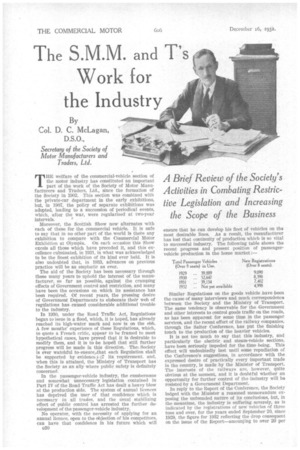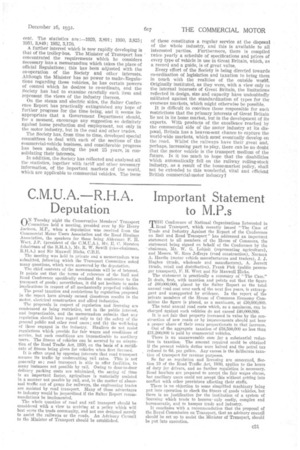The S.M.M. and T'
Page 76

Page 77

If you've noticed an error in this article please click here to report it so we can fix it.
Work for the Industry
By Col. D. C. McLagan,
D.S.O., Secretary of the Society of Motor Manufacturers and Traders, Ltd.
A Brief Review of the Society's Activities in Combating Restrictive Legislation and Increasing the Scope of the Business
THE welfare of the commercial-vehicle section of the motor industry has constituted an important part of the work of the Society of Motor Manufacturers, and Traders, Ltd., since the formation of the Society in 1902. This section was combined with the private-car department in the early exhibitions, but, in 1907, the policy of separate exhibitions was adopted, leading to a succession of periodical events, which, after the war, were regularized at two-year
intervals_ p Moreover, the Scottish Show now alternates with each of these for the commercial vehicle. It is safe to say that in no other part of the world is there any exhibition to compare with the Commercial Motor Exhibition at Olympia. On each occasion this Show excels all those which have preceded it, and this excellence culminated, in 1931, in what was acknowledged to be the finest exhibition of its kind ever held. It is also undoubted that, in 1933, advances on previous practice will be as emphatic as ever.
The aid of the Society has been necessary through these many years to uphold the interest of the manufacturer, SO far as possible, against the cramping effects of Government control and restriction, and many have been the occasions on _which its assistance has been required. Of recent years, the pressing desire of Government Departments to elaborate their web of regulations has caused considerable additional trouble to the industry.
In 1930, under the Road Traffic Act, Regulations began to issue in a flood, which, it is hoped, has already reached its high-water mark and now is on the ebb. A few months' experience of these Regulations, which, to quote a French critic, appear to be framed to meet hypothetical cases, have proved that it is desirable to modify them, and it is to be hoped that still further progress will be made in this direction. The Society is ever watchful to ensurepthat each Regulation shall be supported by evidence“,1 its requirement. and. when this is attained, the Ministry of Transport has the Society as an ally where public safety is definitely concerned_ In the nassenger-vehicle industry, the cumbersome and somewhat unnecessary legislation contained in Part IV of the Road Traffic Act has dealt a heavy blow at the production side. The system of annual licences has deprived the user of that confidence which is necessary in all trades, and the usual stabilizing effect of public control has arrested the further development of the passenger-vehicle industry.
No operator, with the necessity of applying for an annual licence, open to the objection of his competitors, can have that confidence in his future which will c30 ensure that he can develop his fleet of vehicles on tho most desirable lines. As aresult, the manufacturer has lost that continuity of production which is so vital to successful industry. The following table shows the recent progress and present position of passengervehicle production in the •home market:— Similar Regulations on the goods vehicle have been the cause of many interviews and much correspondence between the Society and the Ministry of Transport. The same tendency is observable for the Government and other interests to control goods traffic on the roads, as has been apparent for some time in the passenger services, and the recent effort of the railway -companies, through the Salter Conference, has put the finishing touch to the production of the heavier vehicles.
It is not too much to say that this industry, and particularly the electric and steam-vehicle sections, have been seriously impeded for the time being. This effect will undoubtedly last until some repudiation of the Conference's suggestions, in accordance with the expressed desire of practically every important trade in the country, is made by the Minister of Transport. The interests of the railways are, however, quite obvious at the moment, and it is doubtful whether an opportunity for further control of the industry will be resisted by a Government Department.
In reply to the Report of the Conference, the Society lodged with the Minister a reasoned memorandum exposing the unfounded nature of its conclusions, but, in the meantime, the industry is suffering severely, as is indicated by the registrations of new vehicles of three tons and over, for the years ended September 20, since 1929, the figure for 1932 reflecting the drop consequent on the issue of the Report—amounting to over 20 per cent. The statistics are :-1929, 3,891; 1930, 3,825; 1931, 3,849; 1932, 3,170.
A further interest which is now rapidly developing is that of the trolley-bus. The Minister of Transport has concentrated the requirements which he considers necessary into a memorandum which takes the place of official Regulations; this has been adjusted with the co-operation of the Society and other interests. Although the Minister has no power to make.Reguladons regarding these vehicles, he has certain powers of control which he desires to co-ordinateb and the Society has had to examine carefully each item and represent the views of the industry thereon.
On the steam and electric sides, the Salter Conference Report has practically extinguished any hope of further progress for the time being, and it seems inappropriate that a Government Department should, for a moment, encourage any suggestion so definitely against home production and employment, not only in the motor industry, but in the coal and other trades.
The Society has, from time to time, developed special committees to deal with each of the sections of the commercial-vehicle business, and considerable progress has been made, during the past 25 years, in consolidating their interests.
In addition, the Society has collected and analysed-all the statistics, together with tariff and other necessary information, of the important markets of the world, which are applicable to commercial vehicles. The issue of these constitutes a regular service at the disposal of the whole industry, and this is available to all interested parties. Furthermore, there is compiled twice yearly a schedule of specifications and prices of every type of vehicle in use in Great Britain, which, as a record and a guide, is of great value.
Every effort of the Society is being directed towards co-ordination of legislation and taxation to bring them in touch with the realities of the outside world. Originally Instituted, as they were, with a view only to the internal interests of Great Britain, the limitations reflected in design, size and capacity have undoubtedly militated against the standardization of types for the overseas markets, which might otherwise be possible.
It is difficult to convince those responsible for such restrictions that the primary interests of Great Britain lie not in its home market, but in the development of its exports. With products of the excellence reached by the commercial side of the motor industry at its dispoSal, Britain has a heaven-sent chance to capture the world-wide markets, which must eventually develop on the road. Whilst the railways have their great and, perhaps, increasing part to play, there can be no doubt that the motor vehicle is the transport medium of the future. Is it too much to hope that the disabilities which automatically fell on the railway rolling-stock industry, as a result of the home-market policy, shall not be extended to this wonderful, vital and efficient British commercial-motor industry?




























































































































































